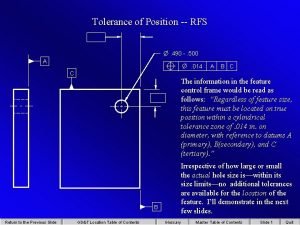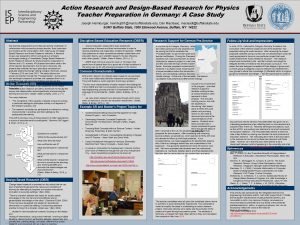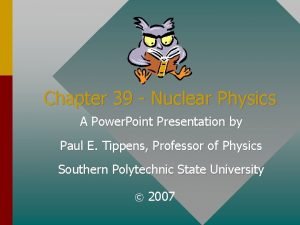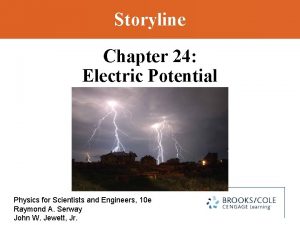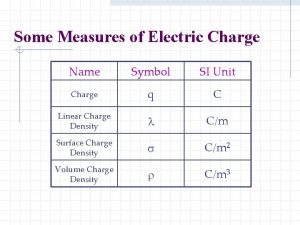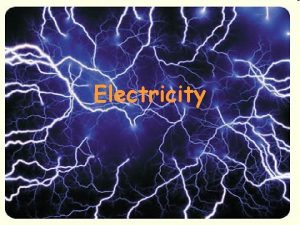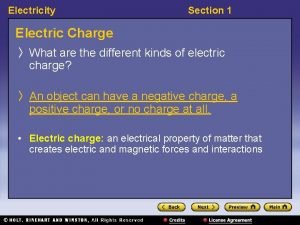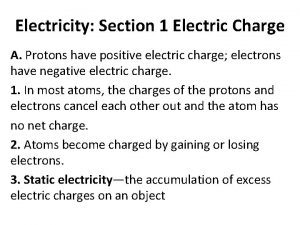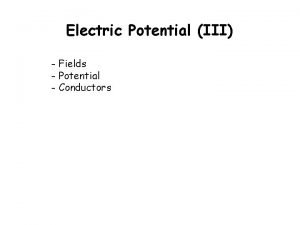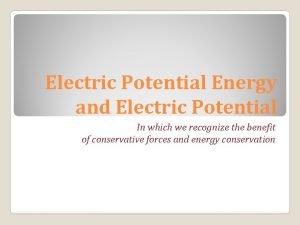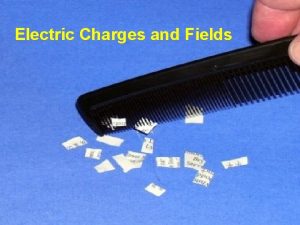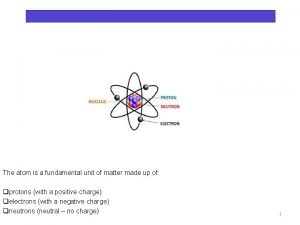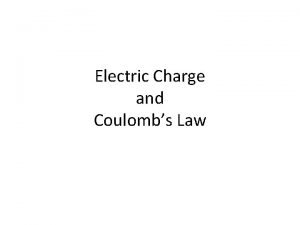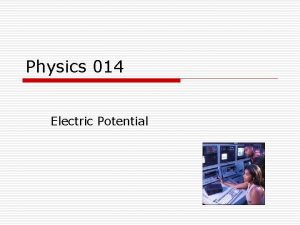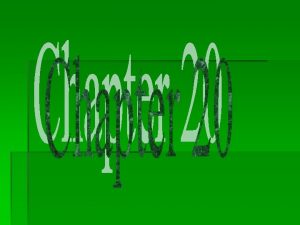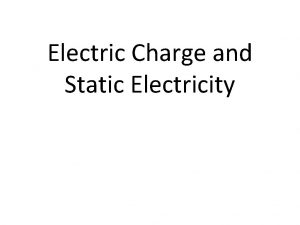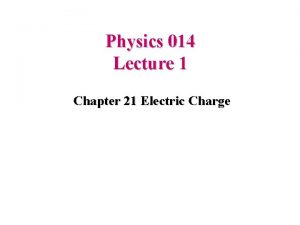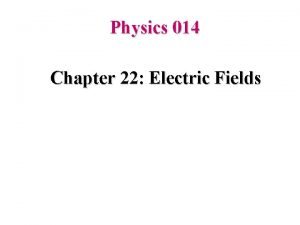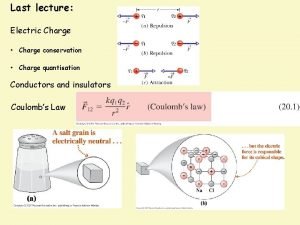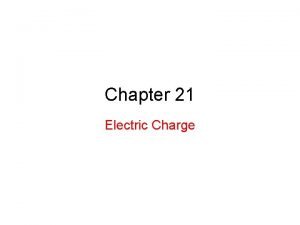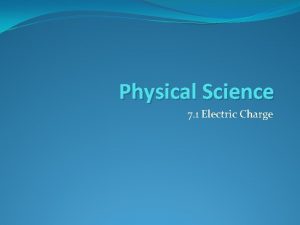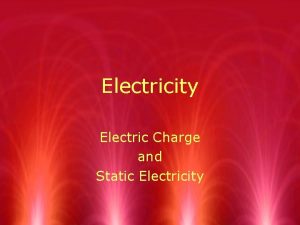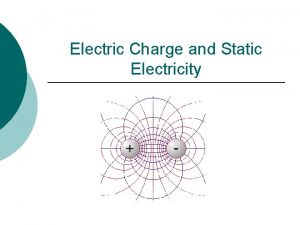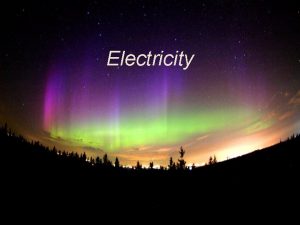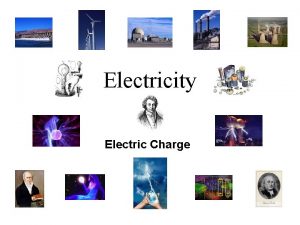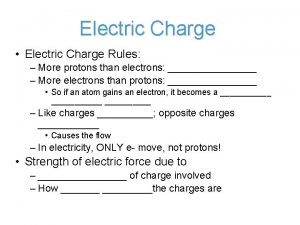Physics 014 Electric Charge Topics o o o





















- Slides: 21

Physics 014 Electric Charge

Topics o o o Electric charge Coulomb’s Law Charge quantization and conservation

Electric Charge Electric charge is an intrinsic characteristic of the fundamental particles making up objects

Electric Charge o o o Positive Charge Negative Charge Most objects are electrically neutral

Electric Charge o o Charges with the same electrical sign repel each other, and charges with opposite electrical signs attract each other

Electrical Charge o o The repulsive or attractive force is called the electrostatic force Electrostatic means the charges are not moving or moving slowly

Charges? The figure shows five pairs of plates: A, B, and D are charged plastic plates and C is and electrically neutral copper plate. The electrostatic forces between the pairs of plates are shown for three of the pairs. For the remaining two pairs do the plates repel or attract each other?

Coulomb’s Law o Unit of charge is the Coulomb, C

Coulomb’s Law Two charges (point charges), q 1 and q 2, separated by a distance r, feel an electrostatic force of attraction or repulsion of magnitude:

Coulomb’s Law o The constant k may be represented in terms of the permittivity constant ε 0

Coulomb’s Law

Coulomb’s Law o A shell of uniform charge attracts or repels a charged particle that is outside the shell as if all the shell’s charge were concentrated at it center

Coulomb’s Law o If a charged particle is located inside a shell of uniform charge, there is no net electrostatic force on the particle from the shell

Coulomb’s Law The figure shows two protons (symbol p) and one electron (symbol e) on an axis. What is the direction of (a) the electrostatic force on the central proton due to the electron, (b) the electrostatic force on the central proton due to the other proton, and (c) the net electrostatic force on the central proton?

Coulomb’s Law Example: Two positive charges are fixed on the x axis. The charges are q 1=1. 60 x 10 -19 C and q 2=3. 20 x 10 -19 C, and the particle separation is R=0. 0200 m. What are the magnitude and direction of the electrostatic force F 12 on particle 1 from particle 2?

Coulomb’s Law

Coulomb’s Law o o Givens & Assumptions q 1=1. 60 x 10 -19 C q 2=3. 20 x 10 -19 C R=0. 0200 m Calc: Eqn:

Coulomb’s Law The figure here shows three arrangements of an electron e and two protons p. (a) Rank the arrangements according to the magnitude of the net electrostatic force on the electron due to the protons, largest first. (b) In situation c, is the angle between the net force on the electron and the line labeled d less than or more than 45 degrees?

Conductors and Insulators o o Conductors are materials through which charge can move freely Insulators are materials through which charge cannot move freely

Conductors and Insulators o o Made of atoms Atoms have n n n Positive protons Negative electrons Neutral neutrons

Conductors and Insulators o o o For the most part, positive charges reside in the nucleus and do not move in objects Electrons may move An object becomes positively charged only through the removal of negative charges
 A 014
A 014 Difference between charge and electric charge
Difference between charge and electric charge Difference between static and current electricity
Difference between static and current electricity Chapter 21 electric charge and electric field
Chapter 21 electric charge and electric field Chapter 21 electric charge and electric field
Chapter 21 electric charge and electric field Electric field k constant
Electric field k constant Chapter 21 electric charge and electric field
Chapter 21 electric charge and electric field Physics investigation ideas
Physics investigation ideas Action research topics in physics
Action research topics in physics Nuclear physics topics for presentation
Nuclear physics topics for presentation Electric field of a finite line charge
Electric field of a finite line charge Units of a charge
Units of a charge What is electric charge measured in
What is electric charge measured in Electrostatics equations
Electrostatics equations Section 1 electric charge crossword puzzle answers
Section 1 electric charge crossword puzzle answers Section 1 electric charge crossword puzzle answers
Section 1 electric charge crossword puzzle answers Section 1 electric charge
Section 1 electric charge Electric field of a finite line charge
Electric field of a finite line charge The electric potential energy of a charge is zero at point
The electric potential energy of a charge is zero at point What is amber effect
What is amber effect Charge on proton
Charge on proton Force between two charges
Force between two charges
